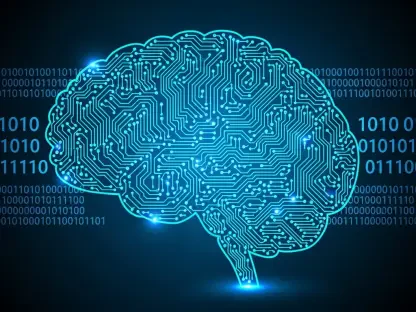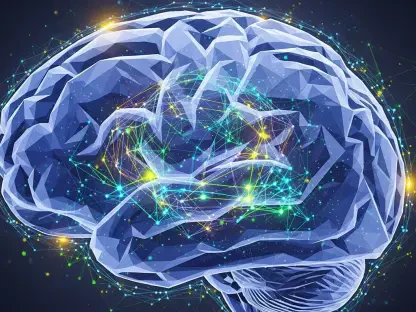Artificial intelligence (AI) is revolutionizing various industries, and web development is no exception. By integrating AI, developers can create websites that are not only faster and more efficient but also significantly more secure. This transformation is enhancing user experiences and driving successful digital outcomes. Let’s explore how AI is reshaping web development, focusing on performance optimization and security enhancements.
AI-Driven Performance Optimization
Domain Name Generators
Finding the perfect domain name can be a daunting task for developers and startups eager to establish a strong online presence. Fortunately, AI simplifies this crucial step by offering customizable search options based on keywords, industry, or style, thereby expediting the brainstorming process. By utilizing AI algorithms, developers can quickly generate a list of relevant and available domain names that align with their brand identity and business objectives. This not only saves valuable time but also ensures a memorable and impactful online address, enhancing the likelihood of attracting and retaining visitors.
Moreover, AI-driven domain name generators can analyze trends and suggest names that are more likely to resonate with the target audience. This predictive approach increases the chances of selecting a domain name that not only reflects the essence of the brand but also ranks well in search engines. In an increasingly competitive digital landscape, having an optimized and strategically chosen domain name can set the foundation for a successful online presence, paving the way for further AI-driven enhancements in web development.
Real-Time Performance Analysis
AI tools can analyze website performance in real-time, providing insights that help optimize loading times and traffic distribution. One significant application of AI in this realm is AI-based caching systems, which store frequently accessed data to facilitate quicker loading times. These intelligent systems predict which parts of a website will be accessed most often and ensure that this data is readily available, significantly improving user experience. Another critical application lies in AI-powered load balancers, which efficiently distribute website traffic, preventing server overloads and ensuring consistent performance even during peak times.
Furthermore, AI-driven performance analysis tools allow developers to continuously monitor and adjust website functionalities, identifying bottlenecks and inefficiencies with remarkable precision. For instance, AI can detect slow-loading pages or high-traffic sections that may require additional resources. By providing real-time feedback and actionable recommendations, these tools empower developers to make immediate improvements, resulting in more responsive and user-friendly websites. The seamless integration of AI in performance optimization represents a pivotal shift towards creating faster, more reliable online platforms.
Predictive Analytics and Personalized Content Delivery
AI leverages data to predict user behavior, optimizing navigation and content delivery. Through the use of tools like heatmaps, developers gain valuable insights into user interactions, such as where users frequently click and how they navigate through the site. This information guides better design decisions, ensuring that the most critical elements are strategically placed to capture user attention. Beyond design, machine learning algorithms analyze user preferences and browsing habits to deliver personalized content, much like Netflix or Amazon. This tailored approach enhances user engagement and satisfaction, fostering a deeper connection with the audience.
Personalized content delivery powered by AI not only improves the user experience but also drives higher conversion rates. By presenting relevant content, products, or recommendations based on individual user data, websites can effectively cater to unique preferences and needs. For instance, an e-commerce site can use AI to suggest products that align with a user’s previous purchases or browsing history, increasing the likelihood of a sale. This level of customization transforms the digital experience, making it more intuitive and engaging, ultimately contributing to the success of the website.
Code Generation and Bug Detection
AI-assisted tools enable developers to write cleaner, faster code, significantly enhancing the overall development process. These advanced tools can suggest code snippets, optimize algorithms, and even generate entire sections of code based on specified parameters. By automating routine coding tasks, developers can focus on more complex and creative aspects of web development, resulting in more efficient and innovative websites. Additionally, AI-powered bug detection systems continuously monitor the codebase for potential issues, identifying and highlighting performance problems or vulnerabilities in real-time.
The ability of AI to detect performance issues and bugs in real-time is a game-changer for web development. Not only does this reduce the time spent on debugging, but it also ensures that websites are more robust and reliable. AI tools can recommend immediate fixes for identified issues, streamlining the debugging process and minimizing the risk of errors going unnoticed. This proactive approach to code generation and bug detection fosters a more agile and responsive development environment, ultimately leading to higher-quality websites that provide superior user experiences.
AI-Driven Security Enhancements
Threat Detection
AI continuously monitors websites, identifying and responding to threats such as hacking attempts. One of the key advantages of AI-driven security measures is their ability to operate autonomously and around the clock, offering protection even when human oversight is not possible. AI-driven firewalls and violation detection systems provide an additional layer of security, ensuring that potential threats are mitigated before they can cause harm. These systems analyze patterns and behaviors indicative of malicious activity, enabling rapid identification and neutralization of attacks.
The proactive nature of AI in threat detection is particularly valuable in the modern digital landscape, where cyber threats are constantly evolving. By leveraging machine learning algorithms, AI can adapt to new threats by learning from previous incidents, continuously improving its defensive capabilities. This dynamic and adaptive approach to security ensures that websites remain protected against emerging threats, maintaining the integrity and confidentiality of user data. The integration of AI-driven threat detection represents a significant advancement in safeguarding online platforms from malicious activities.
Fraud Prevention
Behavioral analytics powered by AI can detect patterns in user behavior, flagging potentially fraudulent activities for review. This capability is particularly crucial for e-commerce and financial platforms, where security is paramount. By analyzing user interactions and transactions, AI systems can identify anomalies that may indicate fraud, such as unusual purchasing patterns or attempts to access sensitive information. This early detection allows for swift action to prevent fraud, protecting both the platform and its users from potential losses.
AI-driven fraud prevention measures are not only effective but also scalable, making them ideal for businesses of all sizes. These systems can handle vast amounts of data, continuously monitoring for suspicious behavior across multiple touchpoints. This comprehensive coverage ensures that even subtle or sophisticated fraudulent activities are detected, providing a robust defense against financial crimes. By integrating AI-powered fraud prevention, businesses can enhance their security posture, instilling confidence in their customers and fostering long-term trust.
Vulnerability Scanning
Automated AI tools can scan websites for security vulnerabilities, notifying developers and suggesting proactive solutions. This continuous scanning ensures that any potential weaknesses are addressed promptly, reducing the risk of data breaches and other security incidents. AI-driven vulnerability scanning tools are capable of identifying a wide range of issues, from outdated software and unpatched vulnerabilities to misconfigurations and weak passwords. By providing detailed reports and actionable recommendations, these tools empower developers to fortify their websites against potential threats.
The ability to conduct regular and thorough vulnerability assessments is essential in maintaining a secure online presence. AI-based scanners can perform these assessments at a frequency and depth that would be challenging to achieve manually. This proactive approach to vulnerability management ensures that websites stay ahead of potential threats, minimizing the risk of exploitation. By integrating AI-driven vulnerability scanning into their security protocols, developers can create more resilient websites that offer a safer experience for users.
Advanced Authentication Mechanisms
AI strengthens authentication through advanced methods such as biometrics, including facial recognition and voice login. These biometric systems use unique physical characteristics to verify a user’s identity, providing a higher level of security compared to traditional passwords. Additionally, multi-factor authentication (MFA) systems further enhance security by requiring multiple forms of verification, such as a password and a biometric scan, making it more difficult for unauthorized users to gain access to sensitive information.
The integration of AI in authentication mechanisms not only improves security but also enhances user convenience. For example, facial recognition technology allows users to log in quickly and securely without the need to remember complex passwords. Similarly, voice login provides a hands-free authentication option, streamlining the user experience. By incorporating AI-driven authentication methods, websites can offer both robust security and user-friendly access, ensuring that only authorized individuals can access protected resources.
Balancing Performance and Security
Traffic Monitoring and Optimization
AI effectively balances the dual objectives of enhancing website performance and bolstering security. Traffic-monitoring AI tools can optimize traffic flow while simultaneously detecting potential security threats. By analyzing patterns in web traffic, these tools can identify abnormal activities that may indicate a cyberattack, such as distributed denial-of-service (DDoS) attacks. At the same time, they ensure that legitimate traffic is efficiently managed, maintaining optimal performance and user experience.
The ability to simultaneously monitor and optimize traffic flow and security is a significant advantage in AI-driven web development. This dual functionality ensures that websites remain fast and responsive, even under high traffic conditions, without compromising on security. By leveraging AI tools, developers can achieve a harmonious balance between performance and protection, providing users with a seamless and secure online experience. This integrated approach is crucial in today’s digital landscape, where both speed and security are essential for success.
Case Study: E-commerce Website
A case study of an e-commerce website illustrates the benefits of AI-driven performance and security enhancements. By using an AI-driven firewall and performance optimization tools, the website experienced improved speed and reduced security incidents. The AI firewall continuously monitored for potential threats, automatically blocking malicious activities and notifying administrators of any suspicious behavior. Simultaneously, AI-based performance tools ensured that the site remained fast and responsive, even during peak shopping periods.
This example demonstrates the win-win potential of AI in web development, providing both efficiency and protection. The e-commerce website not only offered a better user experience through faster loading times and personalized content delivery but also maintained a high level of security, protecting customer data and transactions. This comprehensive approach showcases how AI can transform web development, enabling businesses to thrive in the competitive digital landscape by offering superior performance and robust security.
Future AI Trends in Web Development
AI-Powered Site Builders
AI tools capable of creating entire websites from scratch are becoming increasingly popular. Platforms like Wix are leading the way by leveraging AI to offer users intuitive and efficient site-building experiences. These AI-powered site builders use sophisticated algorithms to analyze user input and generate customized website designs that meet specific needs and preferences. This trend democratizes web development, making it more accessible to a broader audience, including those with limited technical expertise.
As AI-powered site builders continue to evolve, we can expect them to become even more versatile and user-friendly. Future advancements may include more advanced design customization options, better integration with third-party services, and enhanced support for various content types and formats. By automating many of the complex tasks associated with web development, AI tools empower users to create professional-quality websites with minimal effort, significantly lowering the barriers to entry for online entrepreneurship and creativity.
Inclusive Website Features
AI will promote inclusivity by enhancing accessibility features such as real-time captioning and voice commands. These advancements ensure that websites are usable by a wider range of people, including those with disabilities, fostering a more inclusive digital environment. For example, AI-driven screen readers can provide real-time audio descriptions of visual content, making it accessible to visually impaired users. Similarly, voice command systems enable users with mobility limitations to navigate and interact with websites through spoken instructions.
By integrating inclusive features powered by AI, developers can create more accessible and user-friendly websites that cater to diverse audiences. This commitment to inclusivity not only aligns with ethical and legal standards but also broadens the reach of digital content, ensuring that everyone can participate in the online experience. As AI technology continues to advance, we can expect even more innovative solutions to emerge, further enhancing the accessibility and usability of websites for all users.
Advanced SEO Tools
AI-driven SEO tools are revolutionizing how websites achieve higher search engine rankings. These tools analyze vast amounts of data to identify the most effective keywords, monitor competitor strategies, and suggest improvements to content and site structure. By automating many of the manual tasks associated with SEO, AI tools enable developers and marketers to focus on creating high-quality content that appeals to both users and search engines. This ensures that websites not only rank higher but also provide a more engaging and informative experience for visitors.









